The Skylake Core i3 (51W) CPU Review: i3-6320, i3-6300 and i3-6100 Tested
by Ian Cutress on August 8, 2016 9:00 AM ESTLegacy Benchmarks
Some of our legacy benchmarks have followed AnandTech for over a decade, showing how performance changes when the code bases stay the same in that period. Some of this software is still in common use today.
All of our benchmark results can also be found in our benchmark engine, Bench.
3D Particle Movement v1
3DPM is a self-penned benchmark, taking basic 3D movement algorithms used in Brownian Motion simulations and testing them for speed. High floating point performance, MHz and IPC wins in the single thread version, whereas the multithread version has to handle the threads and loves more cores. This is the original version, written in the style of a typical non-computer science student coding up an algorithm for their theoretical problem, and comes without any non-obvious optimizations not already performed by the compiler, such as false sharing.

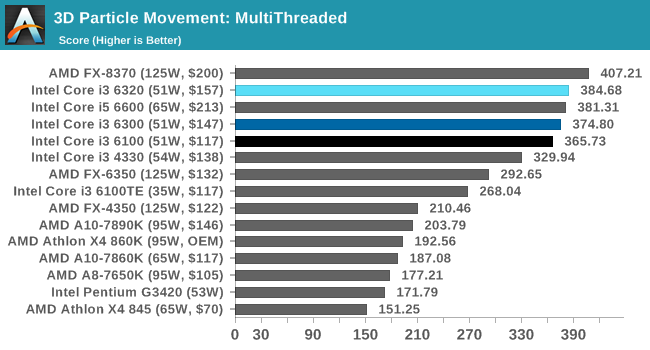
With un-trained programming skills comes a myriad of results. 3DPMv1 is not cache bound, but highly affected by false sharing and IPC. Our Core i3 staircase is in effect, and AMD is badly affected requiring 8 threads to match/beat an i3. In our v2 results, the spread is a more believable, which goes to show that having the right programming paradigm (even just a couple of lines of code) can make a large difference.
CineBench 11.5 and 10
Cinebench is a widely known benchmarking tool for measuring performance relative to MAXON's animation software Cinema 4D. Cinebench has been optimized over a decade and focuses on purely CPU horsepower, meaning if there is a discrepancy in pure throughput characteristics, Cinebench is likely to show that discrepancy. Arguably other software doesn't make use of all the tools available, so the real world relevance might purely be academic, but given our large database of data for Cinebench it seems difficult to ignore a small five minute test. We run the modern version 15 in this test, as well as the older 11.5 and 10 due to our back data.
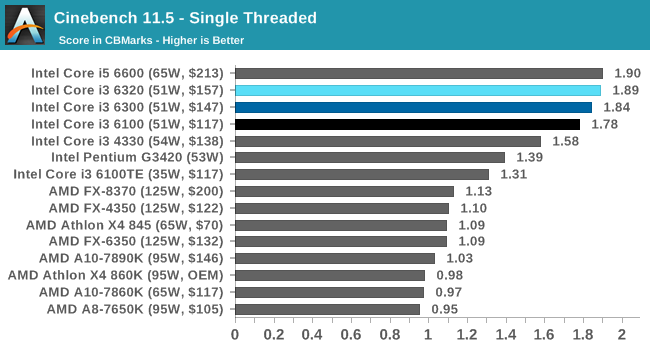
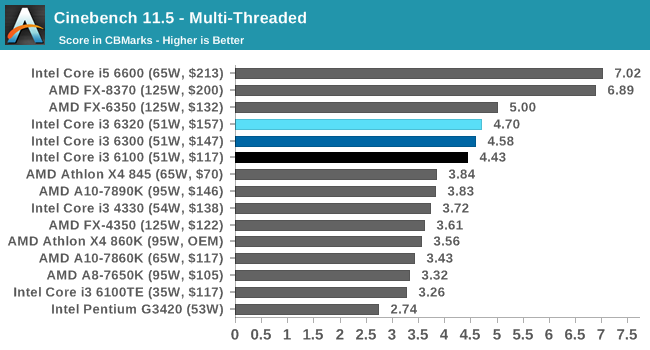
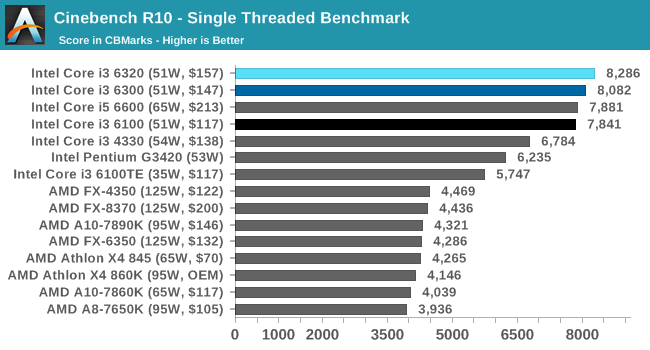

The older CB results mirror the CB15 test, albeit more compressed.
POV-Ray 3.7
POV-Ray is a common ray-tracing tool used to generate realistic looking scenes. We've used POV-Ray in its various guises over the years as a good benchmark for performance, as well as a tool on the march to ray-tracing limited immersive environments. We use the built-in multithreaded benchmark.
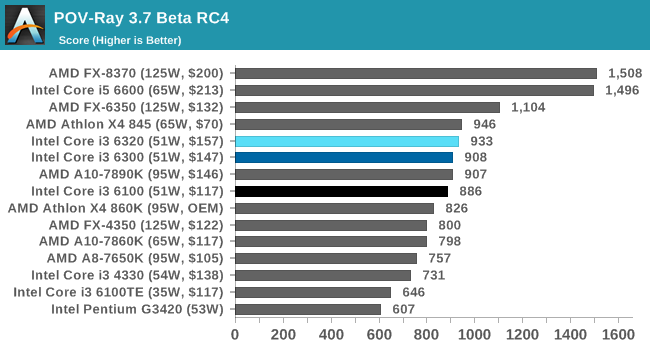
AMD gets a better showing in POV-Ray, with the $70 X4 845 going ahead of all of our Core i3 parts, and the older A10 sitting in between them. The older FX parts, despite their age, take advantage of the multi-threaded nature of the benchmark.
TrueCrypt 7.1
Before its discontinuation, TrueCrypt was a popular tool for WindowsXP to offer software encryption to a file system. The almost latest version, 7.1, is still widely used however the developers have stopped supporting it since the introduction of encrypted disk support in Windows 8/7/Vista from 5/2014, and as such any new security issues are unfixed.
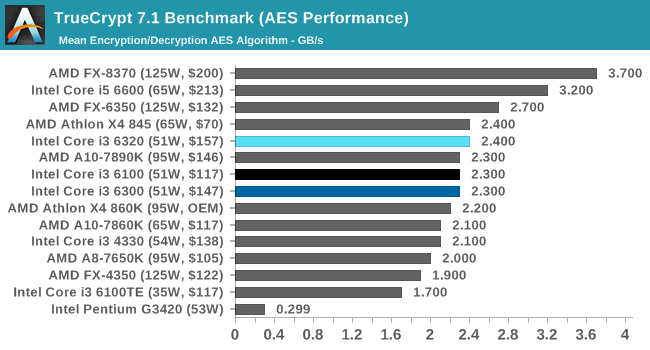
x264 HD 3.0
Similarly, the x264 HD 3.0 package we use here is also kept for historic regressional data. The latest version is 5.0.1, and encodes a 1080p video clip into a high quality x264 file. Version 3.0 only performs the same test on a 720p file, and in most circumstances the software performance hits its limit on high end processors, but still works well for mainstream and low-end. Also, this version only takes a few minutes, whereas the latest can take over 90 minutes to run.
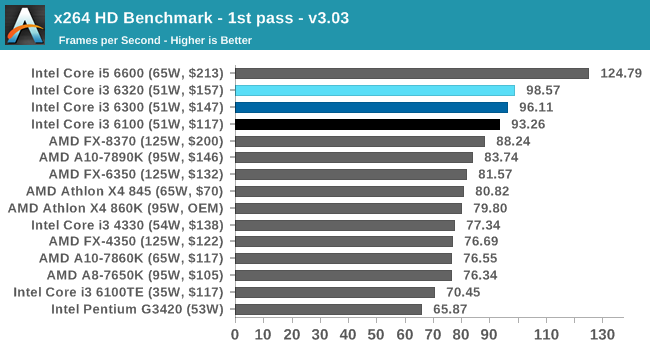
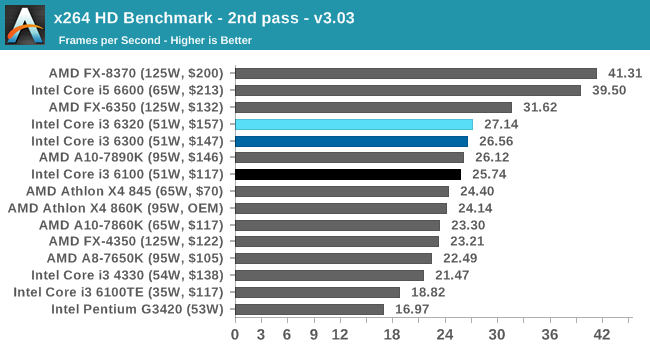
7-zip
7-Zip is a freeware compression/decompression tool that is widely deployed across the world. We run the included benchmark tool using a 50MB library and take the average of a set of fixed-time results.
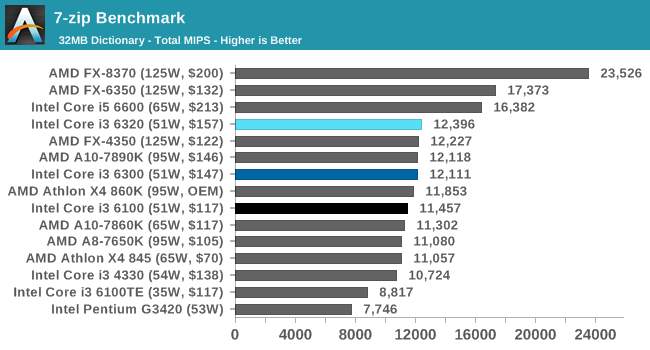










94 Comments
View All Comments
fanofanand - Monday, August 8, 2016 - link
LOL nice. I believe Cellar Door was stating that bug77's comments were poorly educated. :PStas - Sunday, August 14, 2016 - link
Maybe he's just giving us some examples?bug77 - Tuesday, August 9, 2016 - link
Based on two assumptions (and nothing more), you know for certain my comment is poorly educated. Nice.Dritman - Thursday, August 18, 2016 - link
Explain to me then, the benefit of having a faster system if the speed boost is imperceptible to the user. You also have no insight into how the original commenter is using their system. Grow up.Voldenuit - Tuesday, August 9, 2016 - link
>Neah, I went i5-2500k -> i5-6600k and there's no noticeable difference.In gaming or general applications? If gaming, are you on a 60 Hz display? That could be the biggest bottleneck right there, assuming you have a modern GPU to go with that 6600K.
VeauX - Monday, August 8, 2016 - link
I have no compelling reason to retire my 2500K still. Running at 4.5GHz 24/7 for years, it is still able to swallow everything I throw at it without issues. The only thing would be the feature set of the new Chipsets (M2 etc...) but .... meh...kmmatney - Tuesday, August 9, 2016 - link
Last Xmas I bought my son a 2600K + motherboard for less than ~$200 on Ebay. It may be old, but still runs everything without a hitch, and having 8 threads is great when needed. Intel is competeing against itself, including what you can get used nowadays.eaglehide - Monday, August 8, 2016 - link
The graphs are not clickable on the GTA V page.sheh - Monday, August 8, 2016 - link
ECC only in low-end CPUs?!owan - Monday, August 8, 2016 - link
ECC is a Xeon feature once you moving up Intel's food chain. If you need 4+ cores and ECC, you need to get a Xeon